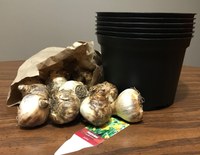Dakota Gardener: Spring Blooms During Winter
(Click an image below to view a high-resolution image that can be downloaded)
By Carrie Knutson, NDSU Extension Agent, Grand Forks County
Forcing spring bulbs such as tulips, daffodils, crocus and hyacinth is a great way to brighten up the dreary days of winter.
Forcing bulbs does require planning, though, because the bulbs need a cooling period that imitates the cold conditions bulbs would experience outside during the winter.
Select only the best bulbs you can find for forcing. Bulbs should be large, firm and free of disease. Look for varieties that are especially suited for forcing.
To start bulbs, use a clean pot at least 6 inches deep that has drainage holes and a saucer to catch the drainage water. Fill the pot about one-third full of new potting soil and arrange the blubs in the pot with the roots down and pointed tip facing up.
Bulbs can be spaced close together but should not be touching each other. Plant the bulbs so the tip of the bulb is near the soil surface. Crocus bulbs should be planted about an inch deep.
Tulip bulbs have a flat side and a rounded side. Plant the flat side facing the inner rim of the pot. This will result in larger leaves growing along the edge of the pot, accenting the flower blooms.
Cover the bulbs completely with additional potting soil. Leave 1/4 inch of space at the top of the pot so when you water, the pot will not overflow.
Water the bulbs after planting and when the soil is dry. Keep the soil moist. Do not allow the soil to dry out because the bulbs also will dry out.
Bulbs need a cooling period of about 12 to 13 weeks at temperatures of 35 to 48 degrees Fahrenheit. You can use unheated space such as an attic or garage or use your refrigerator if you have room. Don’t use a refrigerator if it contains apples. The ethylene gas they emit will harm flower development.
Mark your calendar so you know when you can take the bulbs out of cold storage. Calendar reminders to check soil moisture are helpful, too. If you are forcing bulbs in multiple pots, bring them out of their cooling period at different intervals to extend the bloom time.
When the cooling period has passed, place the bulbs in a warmer (50 to 60 degrees Fahrenheit) area with indirect lighting until they start growing. Once leaves start growing, that is the time to move the bulbs to a warmer area with bright light.
The bulbs will need three to four weeks to grow and flower. The warmer your house, the faster they will grow. Once the flowers begin to bloom, you can place the bulbs in a cooler spot at night to lengthen the bloom time.
All the bulb’s energy is spent once it is done blooming. Forced bulbs usually are discarded. However, you might be able to save them and plant them outside in the fall.
When trying to save bulbs, remove the spent flowers and place the bulbs in a sunny window and keep the soil moist until the foliage turns brown. Then stop watering and allow the soil and foliage to dry down.
Harvest the bulbs, allowing them to dry for a couple of weeks. Then store the bulbs in a cool, dry place until you can plant them in the fall. Happy gardening!
For more information about gardening, contact your local NDSU Extension agent. Find the Extension office for your county at https://www.ag.ndsu.edu/extension/directory/counties.
NDSU Agriculture Communication - Nov. 3, 2020
Source: Carrie Knutson, 701-780-8229, carrie.knutson@ndsu.edu
Editor: Ellen Crawford, 701-231-5391, ellen.crawford@ndsu.edu




